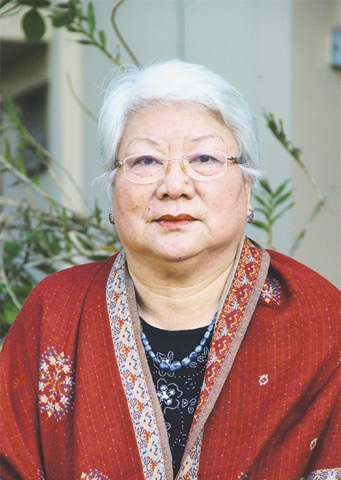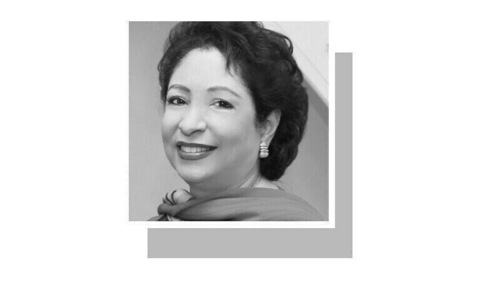
THE question of identity often entails a slippery slope and things get more complex when it comes to India’s North-eastern region. The dominant discourse paints the area as one where violent insurgent activities take place or people have cultures far removed from the rest of the country. In this scenario, it often becomes difficult to sift through all the myths and arrive at a picture more akin to reality. Therefore, it is the job of writers, artists and intellectuals from the region to showcase their land in all its splendour, bereft of stereotypes. Temsula Ao embodies the unique characteristics that go into constituting a Naga identity through her writings as a poet, short story writer and ethnographer.
Ao is a retired professor of English at the North Eastern Hill University, where she taught since 1975. In 2013, she received the Sahitya Akademi Award for her short story collection, Laburnum for My Head. She received the honorary Padmashree Award in 2007 and is also the recipient of the Governor’s Gold Medal 2009 from the government of Meghalaya. Widely respected, she is one of the major literary voices in English to have emerged from North-east India. Excerpts from an interview:
Q: As happens in life, a series of unconnected things somehow get connected at one point, as happened with me meeting you at your residence in Dimapur after constantly bugging you over the phone from Kolkata. Where do we place this attempt of a dialogue between us, strangers till the other day, trying to connect through literature?
A: The confluence of unconnected things in the most unlikely places and impossible times is what makes life so beautifully interesting! The “unlikeliness” of your purpose and my initial reluctance to agree to the interview may be ascribed to the “divides” in which we have been brought up and made to think — different languages, food habits, cultures and that’s only to mention a few. But now that we have started a dialogue, my initial reservations seem to be disappearing because we can now communicate through the language of literature.
When I write, I am not conscious of who I am or what language I am using to express my thoughts. I am only aware that there are certain feelings and ideas, which are clamouring to be expressed and that is how writing happens. The reason I write in English is because I feel at “home” in that medium. That also might be as all my life I taught English for a living.
Q: In your memoir, Once upon a Life, you have quoted Gore Vidal as saying, “A memoir is how one remembers one’s life, while an autobiography is like history — requiring research where dates and facts have to be double-checked.” By freeing yourself from the tyranny of auditing one’s life, you wrote an intimate memoir, which, as you admit in the preface, is not an easy task. How difficult was the process of letting things go? Also, did you punctuate your memoir writing after a point or did you blurt out everything like an act of exorcism?
A: Exorcism is a strong word and I believe that it also carries a negative connotation. The reason I decided to call my life’s story a “memoir” is because the reliance is more on memories, impressions of those experiences that are indelibly imprinted on my mind. Besides, the research involved in an autobiography was something beyond my interest.
Also, this book is about a lonely girl and not an artist. As I explained in the preface, the urge to write the book is my way of telling my children and grandchildren about the deprivations and inadequacies of my life so that they appreciate what they have now. Instead of exorcism, perhaps it has been a form of catharsis.
Q: But do writers live twice, once through the actual experience and then again processing it for writing?
A: I do not know how to answer this because I believe that writers live as normally or otherwise like everybody else. Maybe their perceptions differ about important issues affecting the general population but writing does not mean any processing of actual experiences as such. At best, indelible real-life experiences may provide the writer the incentive or a trigger to weave a narrative for a poem or a novel. As for living twice, the definition will be as varied as there are writers.

Q: Discovering the “other” is an in-thing with the media. In the context of the North-east, it is best visible when the Hornbill Festival or violent strikes take place. Exotica or political turbulence are the prisms through which the rest of India get to see the region. What’s your take on stereotyping the North-eastern identity?
A: The North-eastern identity is a misnomer because the region is home to a multitude of people with diverse languages, cultures, costumes and, therefore, no one should use this term because it defaces the real identity of the people living here. At best, it has only a geographical and geo-political relevance. And the Hornbill Festival is the commercial face of the Naga identity.
Q: In an essay, Venusa Tunyi writes about an incident involving Mahatma Gandhi where he wished to visit Naga areas and teach local people to weave clothes. He was obviously ignorant about the existing traditional attire that incorporates complex designs and the skill and creativity behind such intricate patterns. Do you see any shift or change in the gaze towards the North-east today?
A: Mahatma Gandhi’s wish only reiterates the commonly held notion of outsiders that Nagas wore “naked”-looking garments because they did not know the art of weaving. But it barely needs reminding that such “half-naked” garments were worn by other tribals, too. And each culture followed their own concept of the human body through traditional clothes, tattoos and strategic bead-wear for women.
Q: The last part of Book of Songs is sub-titled, Songs from the Other Life. I feel this wonderful sense of ownership of the poet towards a rich tradition filled with myths and tales, which were passed on to her orally. You used your inheritance and blended it with the self in a poem like Soul-Bird. What was the background to its creation?
There is no background as such for the poem Soul-Bird. In it, I wrote about an ancient belief prevalent among our people that when a person dies, the soul leaves the body and turns into a bird, insect or even a stone or stick. I think the explanation is appended with poem. I must confess that the grandmother figure is my own maternal grandmother who came from the village after my mother died. When she visited her grave, my grandmother swore she saw a bird flying away into the distance. The image of her crying over the graveside haunted me for years.
Q: In the poem The Other World, you draw from the Sangtam Naga legend of Momola where she was transformed into a giant fish with a distinctive white spot on her forehead. How do you deal with the white spot of identity as a Naga in your writings, especially in the context of globalisation when such markers are being wiped off or getting blurred?
A: Momola may have had a white spot but Temsula here has learned to camouflage the white spots in her life! However, in my writing I would like to retain the white spots because they give me a certain identity of being a Naga writing in a language not her mother tongue. Though confined to a limited range, her writings have found some sweet responses in kindred minds. I thank God for such white spots!
Q: Your magical poem Bat-Cloud gives the impression of being a mythical story but it’s about the political conflicts affecting the lives of citizens. Amid reports of violence on a regular basis, how do you retain the vitality in your writing?
A: If a writer depends entirely on externals, be they blood and gore or sweet nothings, he/she is bound to reach a dead-end. But what is culled from real-life experiences can always be transformed by imagination into something beautiful, sad, funny or downright nonsense by the skill of a sincere writer. I believe that forms the core of art and will constantly invigorate the efforts of any writer.
Q: Naga painter and art critic Iris Odyuo has an observation about incorporating traditional Naga motifs onto Western-style jackets and neckties for men, which were previously unknown to Nagas. Such items are worn during official meetings, festivals and have come to be recognised as representing the symbols of Naga identity. What’s your take on this?
A: About Odyuo’s comment, I can only add that it is another form of “commercialising” the intrinsic weaving culture of every Naga tribe. Such items find markets easily elsewhere but there are important protocols about wearing these garments. Each tribe has distinctive colour schemes and designs, and one would never venture to wear another tribe’s garment because then he/she will be criticised for betraying their identity. In this way, Nagas have been able to preserve their individual identities even amid the chaos of the so-called globalisation.
—By arrangement with The Statesman/Bangladesh
Published in Dawn, October 28th, 2015
On a mobile phone? Get the Dawn Mobile App: Apple Store | Google Play














































